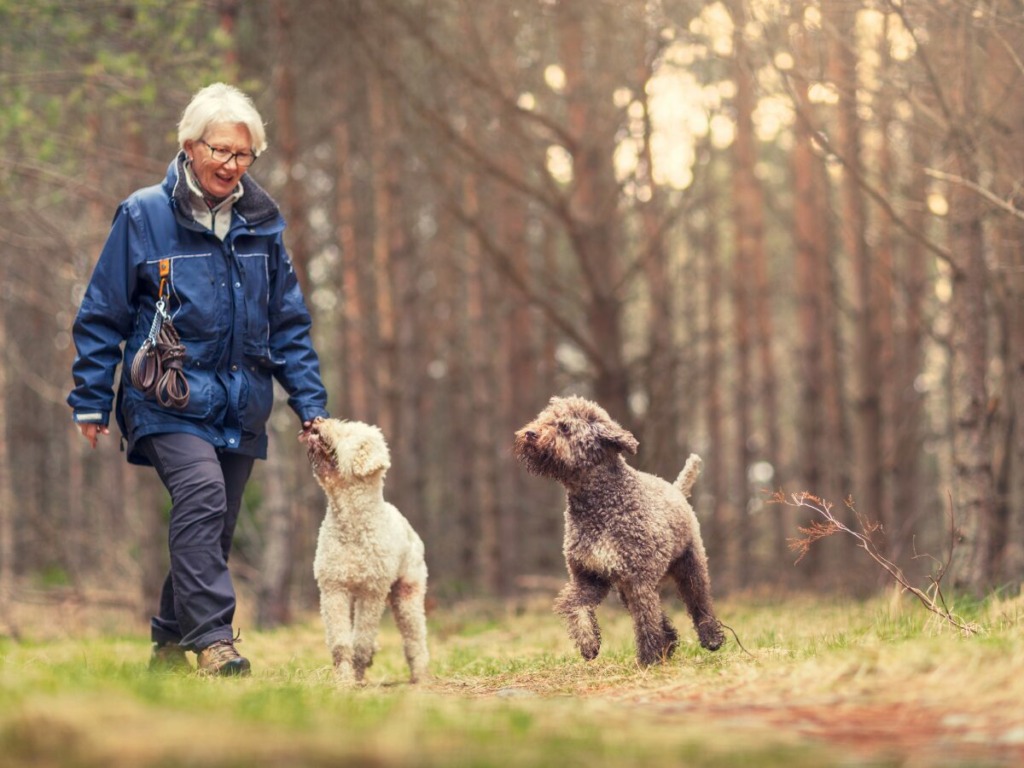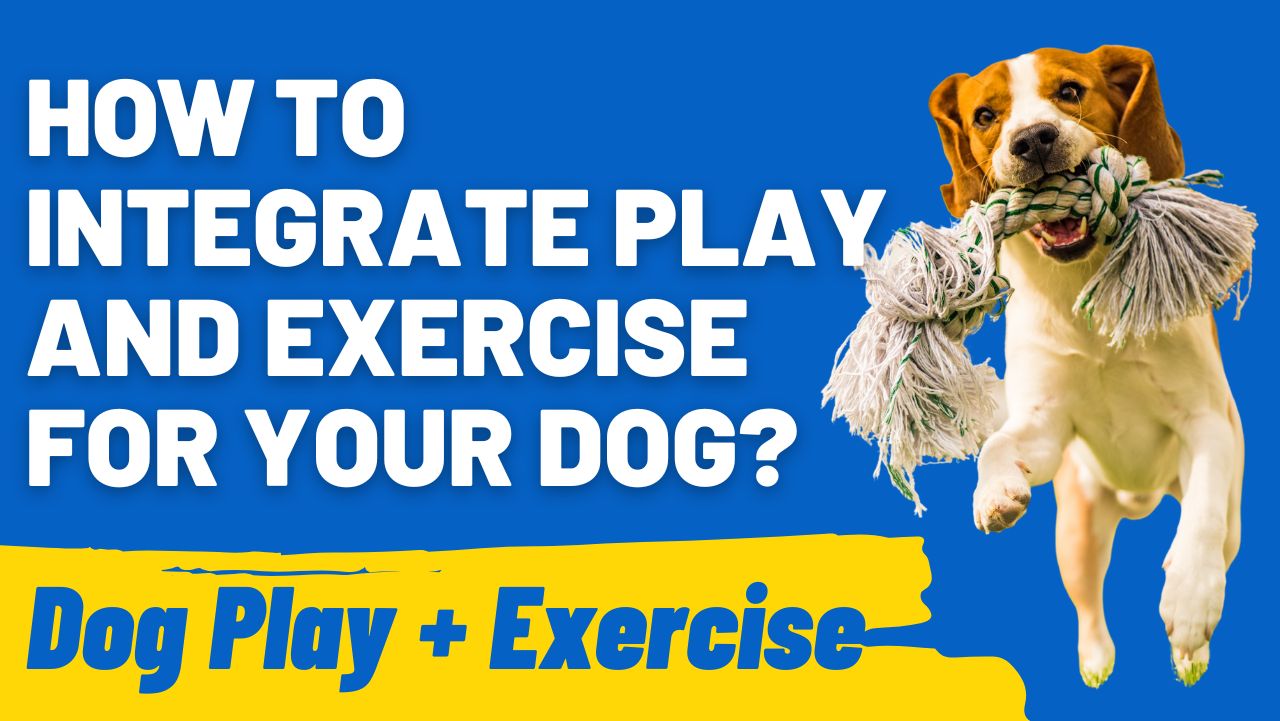Ensuring a healthy and fulfilling life for our dogs involves more than just regular feedings and routine check-ups. Integrating play and exercise into their daily lives plays a crucial role in maintaining their physical and mental well-being.
This blog focuses on the various strategies and practices to effectively blend play and exercise, catering to dogs of different sizes, energy levels, and life stages.
From understanding the importance of physical dog activity to exploring creative exercise ideas and monitoring their health, we got it covered!
Why is Exercise Crucial for Your Canine Companion?
Just like humans, dogs require physical activity to maintain their health and vitality. The benefits of a well-exercised dog extend far beyond just physical canine fitness; they include improved mental health, socialization, and behavior.
Regular exercise helps to keep a dog’s muscles strong and their body agile, reducing the risk of obesity, joint problems, and other health issues. It also helps to regulate their digestive system and improve cardiovascular health.
Active dogs tend to have a more robust immune system and are less prone to diseases that are common in sedentary pets.
Furthermore, the connection between exercise and canine health is evident in their mental well-being. Dogs that receive adequate physical activity are generally happier and more balanced.
Exercise provides an outlet for their energy, reducing the likelihood of destructive behaviors such as chewing, digging, and excessive barking.
It also helps alleviate symptoms of anxiety and depression, which can be prevalent in dogs, especially those who spend long hours alone.
The benefits of exercise are not limited to physical and mental health alone; it also strengthens the bond between the dog and its owner.
Engaging in activities together promotes a deeper understanding and communication between the two, enhancing the overall relationship.
Balancing Play and Exercise

Creating Fun Exercise Routines
Finding the right exercise routine for your dog’s breed and age is crucial for their overall health. Different breeds have varying energy levels and physical capabilities, so it’s important to tailor the exercise routine to suit your dog’s specific needs.
For example, a Border Collie will require more intense physical activity compared to a Bulldog.
Similarly, puppies and senior dogs have different exercise requirements compared to adult dogs.
Incorporating play into your dog’s daily routine is an effective way to ensure they are getting enough exercise while also keeping them engaged and happy.
Play can include a variety of activities such as fetch, tug-of-war, and agility training. These activities not only provide fun workouts but also encourage mental stimulation.
Keeping your dog engaged during exercise is important for maintaining their interest and enthusiasm. This can be achieved by varying the types of activities and incorporating new challenges regularly.
It’s also beneficial to exercise in different environments, such as parks, beaches, or hiking trails, to provide new sensory experiences for your dog and foster better canine wellness.
Mental Stimulation through Play
The role of mental stimulation in a dog’s overall health is often underestimated. Mental exercise is as important as physical activity, as it helps to keep a dog’s mind sharp and prevent cognitive decline, especially in older dogs.
Engaging in mentally stimulating activities can also help reduce problem behaviors and anxiety.
Games and activities that provide mental exercise include puzzle toys, hide-and-seek, and training sessions that challenge your dog to learn new commands or tricks.
These activities not only entertain your dog but also strengthen the bond between you and your pet.
Combining physical and mental stimulation for a well-rounded experience is key to a dog’s overall well-being. A balance of both ensures that your dog is not only physically fit but also mentally healthy and happy.
This holistic approach to exercise and play can lead to a more fulfilling and enjoyable life for both the dog and its owner.
Interested in reading our post about Peachy Keen for Pooches: Can Dogs Eat Peaches?
Dog Training and Exercise
Training plays a vital role in enhancing your dog’s exercise regimen. Incorporating training into a dog’s physical activities not only improves their physical fitness but also sharpens their mental acuity and obedience.
Training exercises, such as fetch, agility courses, or frisbee, combine the benefits of physical exercise with the mental stimulation of following commands and solving problems.
Integrating obedience training into active playtime is an effective way to reinforce good behavior while keeping your dog engaged and entertained.
For instance, you can use playtime to practice commands like ‘sit’, ‘stay’, ‘come’, and ‘drop it’, which are essential for a dog’s discipline and safety.
This play and exercise integration helps dogs associate obedience with fun and rewards, making them more eager to follow commands.
The importance of consistent exercise for behavior management cannot be overstated. Regular physical activity helps to expend excess energy that might otherwise be channeled into destructive or undesirable behaviors.
Dogs that are well-exercised are generally more relaxed, attentive, and easier to train. They are less likely to exhibit issues such as excessive barking, chewing, or hyperactivity, which can stem from boredom or pent-up energy.
Creative Exercise Ideas for Your Furry Friend
Interactive Toys and Games
Interactive toys and games are fantastic ways to keep your dog physically and mentally stimulated.
Top interactive toys and games include puzzle feeders, treat-dispensing balls, and tug toys, which encourage active play while also challenging your dog’s problem-solving skills.
HoundGames offers a variety of such toys that are perfect for keeping your dog engaged and active.
For instance, the HoundGames Dog Puzzle Toys are an excellent choice for mental stimulation.
These toys feature adaptable puzzle treat dispenser blocks with different difficulty levels, making them suitable for dogs of various intelligence and skill levels.
As your dog solves the puzzles, treats are dispensed as a reward, encouraging their problem-solving skills and providing hours of fun.
DIY toys are another great option to keep your dog entertained and can be made from household items such as old t-shirts or water bottles.
For example, you can create a tug toy by braiding strips of an old t-shirt or a puzzle toy by placing treats inside a cardboard box with holes.
Safety precautions when using toys are essential. Always choose toys that are appropriate for your dog’s size and chewing habits.
Regularly inspect toys for wear and tear, and discard any that are broken or could pose a choking hazard.
Outdoor Adventures
Exploring the great outdoors with your dog is not only fun but also beneficial for their health. Activities like hiking, jogging, and biking are excellent ways to enjoy nature while providing your dog with ample playful exercise.
These activities cater to a dog’s natural instincts to explore and can be incredibly rewarding for both the dog and the owner.
Safety tips for outdoor activities are important to consider. Always keep your dog on a leash or harness in unfamiliar or wildlife-rich areas, and make sure they are wearing identification tags.
Bring water for both you and your dog, and be mindful of weather conditions to avoid heatstroke or hypothermia.
Indoor Exercise Solutions
Staying active on rainy or cold days can be challenging, but there are plenty of indoor games and exercises to keep your dog moving.
Activities like hide-and-seek, indoor fetch, and obstacle courses can be set up in your home to provide both physical and mental stimulation.
Creating an indoor exercise space for your dog can be as simple as clearing a room or hallway for play. You can use furniture to create makeshift agility courses or use toys that encourage jumping and chasing.
HoundGames offers a variety of toys that are perfect for indoor play, such as the Puppy Toy Mat with Teething Chew Toys, which includes multiple chew and rope toys, a nose squeaker, and a high-quality foam mat.
This all-in-one product not only stimulates your dog’s senses, reducing boredom and anxiety, but also serves as a comfortable nap space.
Sample Exercise Routine

Below is a table displaying a sample exercise routine for dogs of different sizes and energy levels. This table includes the duration, type of exercise, and frequency, offering a guideline to help you create a balanced and effective exercise plan for your dog. Keep in mind that individual needs may vary based on dog health, age, and specific breed characteristics.
| Dog Size & Energy Level | Type of Exercise | Duration | Frequency |
| Small Size / Low Energy | Short walks, Indoor play, Gentle fetch | 15-20 minutes | 2-3 times a day |
| Small Size / High Energy | Brisk walks, Tug-of-war, Agility games | 20-30 minutes | 2-3 times a day |
| Medium Size / Moderate Energy | Regular walks, Fetch, Basic training exercises | 30-40 minutes | 2 times a day |
| Medium Size / High Energy | Jogging, Hiking, Advanced training exercises | 40-50 minutes | 1-2 times a day |
| Large Size / Moderate Energy | Long walks, Swimming, Fetch | 40-50 minutes | 1-2 times a day |
| Large Size / High Energy | Running, Hiking, Intense agility training | 50-60 minutes | 1-2 times a day |
Monitoring Your Dog’s Physical Health
Monitoring your dog’s physical health is an essential aspect of responsible pet ownership. It involves regular observation and assessment of your dog’s physical and behavioral changes, which can be indicators of their overall well-being.
A comprehensive approach to monitoring includes several key areas: physical examination, behavior observation, exercise response, diet and nutrition, and veterinary care.
Physical Examination
Regular physical examination of your dog can help you detect any abnormalities or changes in their body.
This includes checking their coat for luster and absence of parasites, examining their eyes and ears for any discharge or inflammation, and observing their gait for any signs of discomfort or limping.
Additionally, monitoring their weight is crucial to ensure they are not underweight or overweight, which can lead to health issues.
Behavior Observation
Changes in your dog’s behavior can be a significant indicator of their health. Look out for signs such as increased lethargy, lack of interest in activities they usually enjoy, changes in sleeping patterns, or unusual aggression.
Behavioral changes can signal underlying health problems, stress, or discomfort, and should be addressed promptly.
Exercise Response
Observing your dog’s response to balanced exercise is vital. While regular exercise is beneficial, it’s important to recognize the signs of overexertion or discomfort.
Symptoms such as excessive panting, reluctance to continue exercise, or fatigue after normal activities can indicate that your dog is being pushed beyond their limits.
Adjust the intensity and duration of exercise based on your dog’s age, breed, and health condition.
Diet and Nutrition
A balanced diet is fundamental for your dog’s health. Monitor their eating habits and ensure they are receiving the right amount of nutrients. Sudden changes in appetite or weight can be a sign of health issues.
Be mindful of their water intake as well, especially during and after exercise, to prevent dehydration.
Veterinary Care
Regular veterinary check-ups are essential for maintaining your dog’s health. These visits provide an opportunity for professional health assessments, vaccinations, and early detection of potential health issues.
Your veterinarian can also offer guidance on your dog’s diet, exercise routine, and overall care based on their specific needs.
Special Considerations for Different Life Stages

Different life stages of dogs require different health monitoring approaches:
- Puppies: They need frequent monitoring to ensure proper growth and development. Pay attention to their energy levels, appetite, and response to vaccinations.
- Adult Dogs: Maintain a consistent health monitoring routine. Look for any signs of common adult dog issues like dental problems, obesity, or joint issues.
- Senior Dogs: Older dogs may require more frequent health checks. Monitor for signs of aging, such as hearing loss, vision impairment, or cognitive changes.
Monitoring Tools and Techniques
- Activity Trackers: These devices can help monitor your dog’s physical activity and rest patterns, providing insights into their overall health.
- Regular Weight Checks: Use a scale to regularly check your dog’s weight, ensuring they maintain a healthy weight range.
- Health Diaries: Keeping a diary of your dog’s health-related observations can be useful for identifying patterns or changes over time.
Monitoring your dog’s physical health is a multifaceted approach that requires regular observation, preventive care, and prompt attention to any changes.
By being proactive in health monitoring, you can ensure your dog enjoys a long, happy, and healthy life.
Early detection of potential health issues can make a significant difference in treatment success and your dog’s quality of life.
Conclusion
Incorporating healthy play and exercise into your dog’s routine is an essential aspect of pet care that goes beyond mere physical health. It’s about enriching their lives, fostering a deeper bond between you and your pet, and ensuring their overall happiness.
Through the strategies and ideas discussed in this article, we hope to empower dog owners with the knowledge and tools needed to provide a stimulating and healthy environment for their canine companions.




